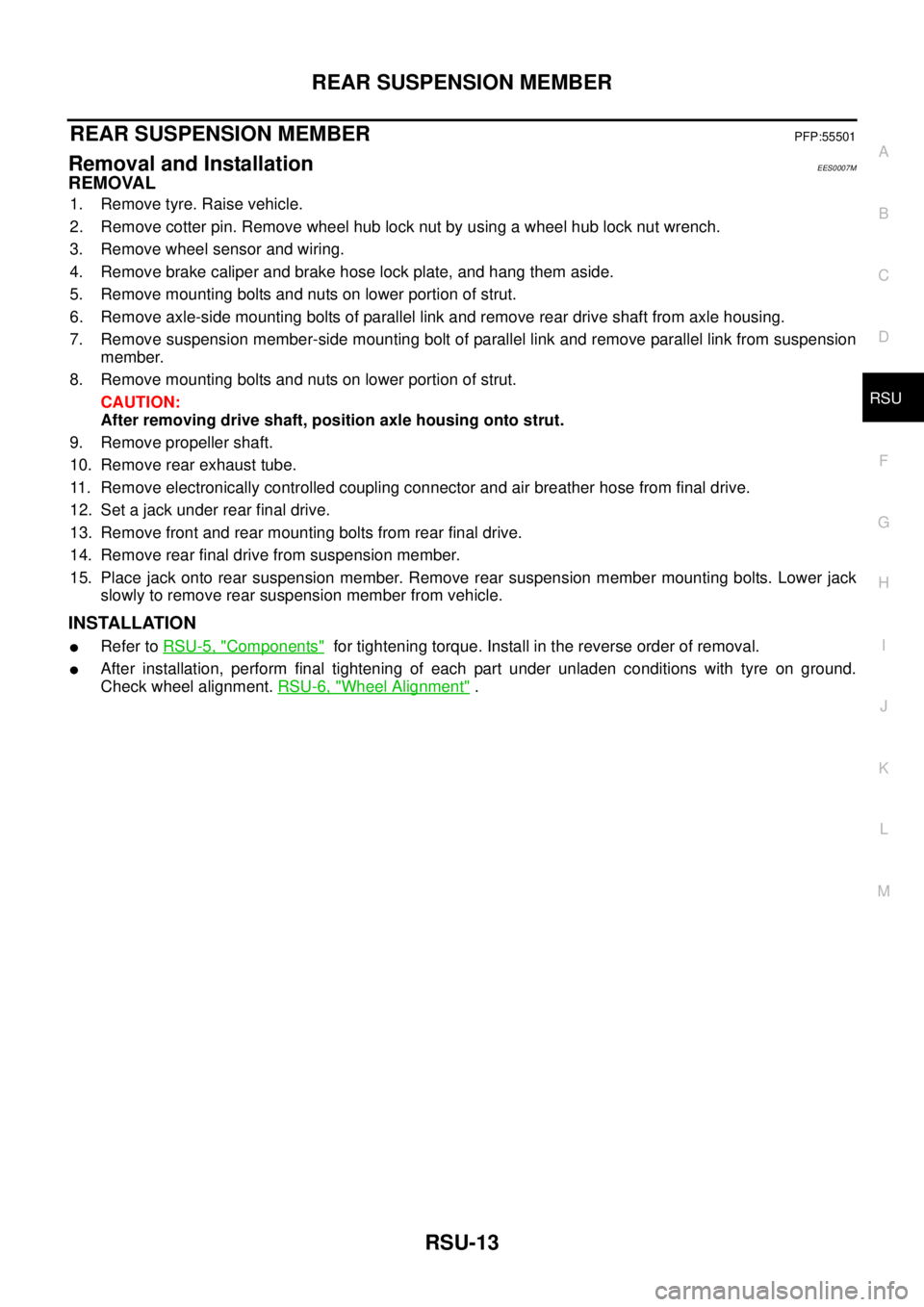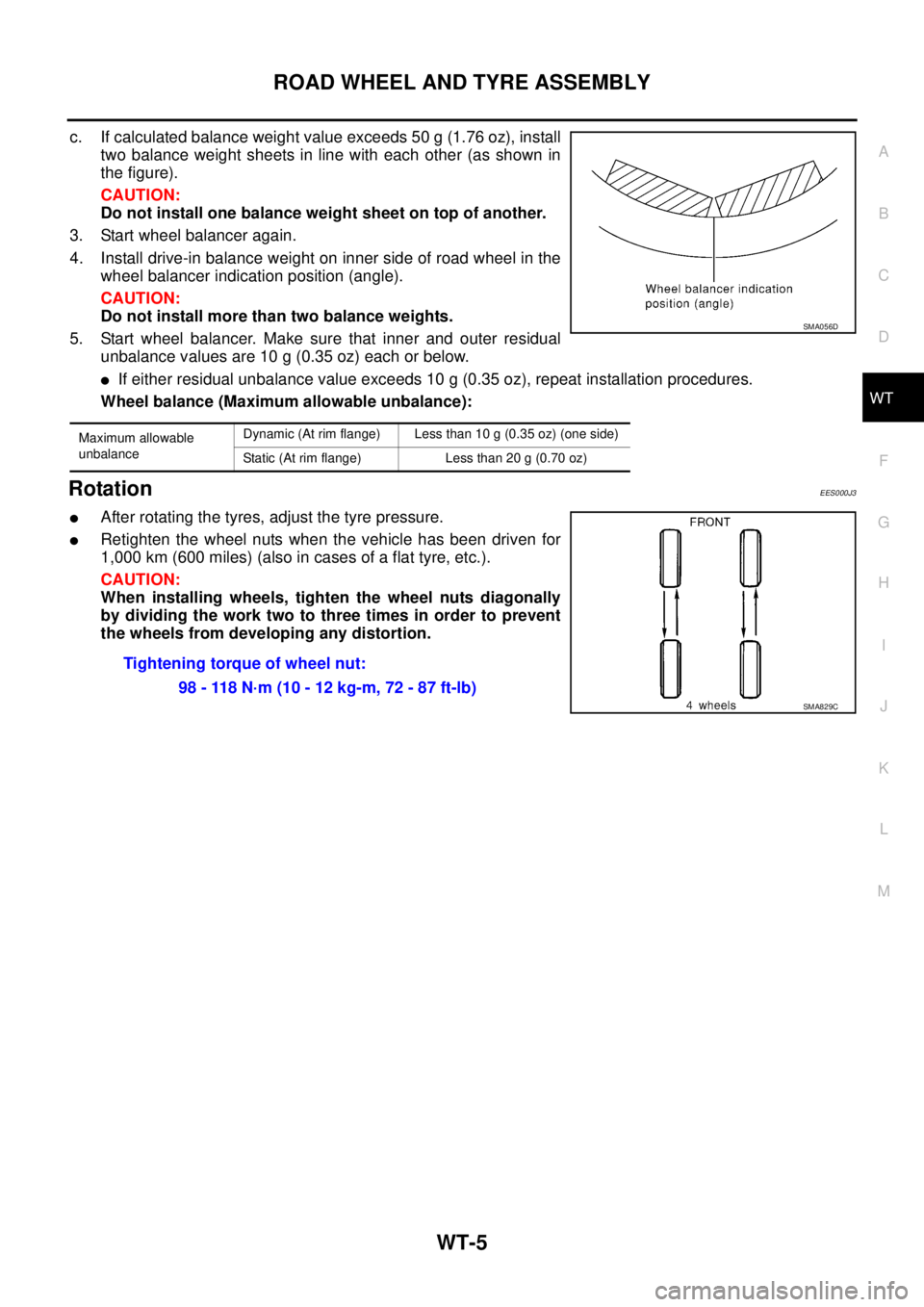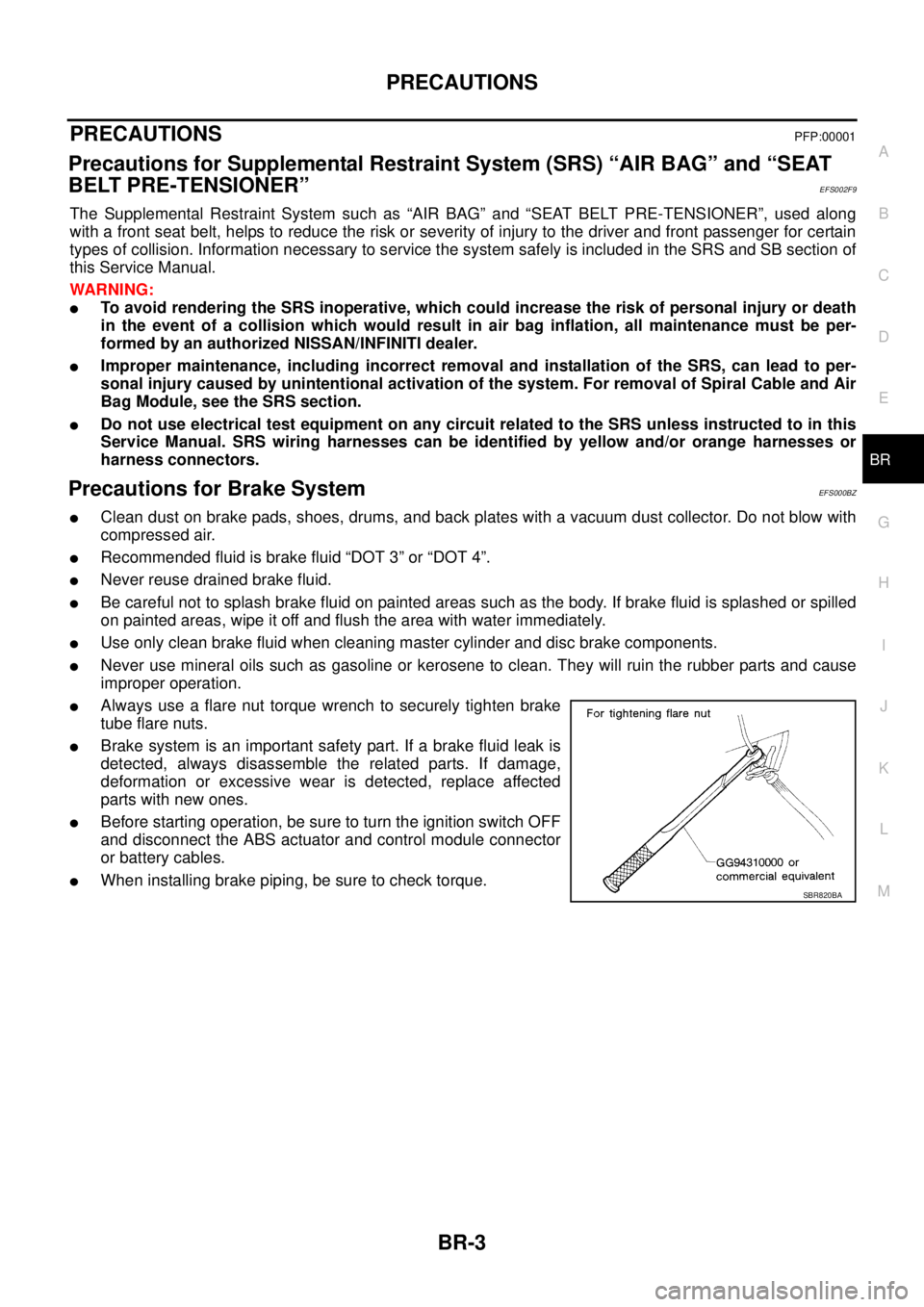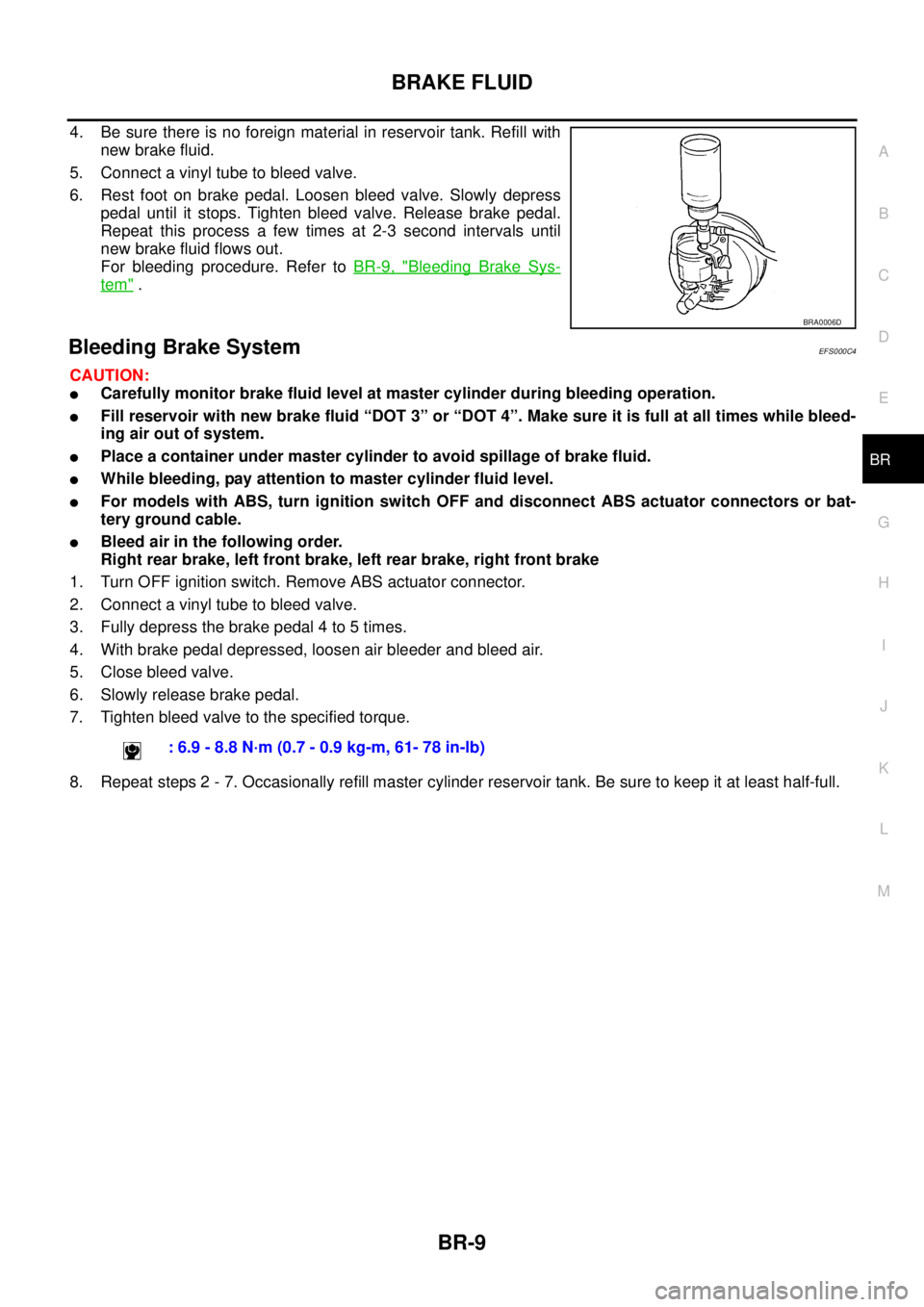Page 2990 of 4555
RSU-12
RADIUS ROD
RADIUS RODPFP:55110
Removal and InstallationEES0007L
REMOVAL
1. Remove tyre, Raise vehicle.
2. Remove radius rod mounting bolts and nuts and remove radius rod from vehicle.
INSPECTION AFTER REMOVAL
�Check radius rod and busing for deformation, cracks, and damage, and replace if necessary.
INSTALLATION
�Refer to RSU-5, "Components" for tightening torque and reverse the removal procedure for installation.
Page 2991 of 4555

REAR SUSPENSION MEMBER
RSU-13
C
D
F
G
H
I
J
K
L
MA
B
RSU
REAR SUSPENSION MEMBERPFP:55501
Removal and InstallationEES0007M
REMOVAL
1. Remove tyre. Raise vehicle.
2. Remove cotter pin. Remove wheel hub lock nut by using a wheel hub lock nut wrench.
3. Remove wheel sensor and wiring.
4. Remove brake caliper and brake hose lock plate, and hang them aside.
5. Remove mounting bolts and nuts on lower portion of strut.
6. Remove axle-side mounting bolts of parallel link and remove rear drive shaft from axle housing.
7. Remove suspension member-side mounting bolt of parallel link and remove parallel link from suspension
member.
8. Remove mounting bolts and nuts on lower portion of strut.
CAUTION:
After removing drive shaft, position axle housing onto strut.
9. Remove propeller shaft.
10. Remove rear exhaust tube.
11. Remove electronically controlled coupling connector and air breather hose from final drive.
12. Set a jack under rear final drive.
13. Remove front and rear mounting bolts from rear final drive.
14. Remove rear final drive from suspension member.
15. Place jack onto rear suspension member. Remove rear suspension member mounting bolts. Lower jack
slowly to remove rear suspension member from vehicle.
INSTALLATION
�Refer to RSU-5, "Components" for tightening torque. Install in the reverse order of removal.
�After installation, perform final tightening of each part under unladen conditions with tyre on ground.
Check wheel alignment. RSU-6, "
Wheel Alignment" .
Page 2997 of 4555

ROAD WHEEL AND TYRE ASSEMBLY
WT-5
C
D
F
G
H
I
J
K
L
MA
B
WT
c. If calculated balance weight value exceeds 50 g (1.76 oz), install
two balance weight sheets in line with each other (as shown in
the figure).
CAUTION:
Do not install one balance weight sheet on top of another.
3. Start wheel balancer again.
4. Install drive-in balance weight on inner side of road wheel in the
wheel balancer indication position (angle).
CAUTION:
Do not install more than two balance weights.
5. Start wheel balancer. Make sure that inner and outer residual
unbalance values are 10 g (0.35 oz) each or below.
�If either residual unbalance value exceeds 10 g (0.35 oz), repeat installation procedures.
Wheel balance (Maximum allowable unbalance):
RotationEES000J3
�After rotating the tyres, adjust the tyre pressure.
�Retighten the wheel nuts when the vehicle has been driven for
1,000 km (600 miles) (also in cases of a flat tyre, etc.).
CAUTION:
When installing wheels, tighten the wheel nuts diagonally
by dividing the work two to three times in order to prevent
the wheels from developing any distortion.
Maximum allowable
unbalanceDynamic (At rim flange) Less than 10 g (0.35 oz) (one side)
Static (At rim flange) Less than 20 g (0.70 oz)
SMA056D
Tightening torque of wheel nut:
98 - 118 N·m (10 - 12 kg-m, 72 - 87 ft-lb)
SMA829C
Page 3001 of 4555

PRECAUTIONS
BR-3
C
D
E
G
H
I
J
K
L
MA
B
BR
PRECAUTIONSPFP:00001
Precautions for Supplemental Restraint System (SRS) “AIR BAG” and “SEAT
BELT PRE-TENSIONER”
EFS002F9
The Supplemental Restraint System such as “AIR BAG” and “SEAT BELT PRE-TENSIONER”, used along
with a front seat belt, helps to reduce the risk or severity of injury to the driver and front passenger for certain
types of collision. Information necessary to service the system safely is included in the SRS and SB section of
this Service Manual.
WARNING:
�To avoid rendering the SRS inoperative, which could increase the risk of personal injury or death
in the event of a collision which would result in air bag inflation, all maintenance must be per-
formed by an authorized NISSAN/INFINITI dealer.
�Improper maintenance, including incorrect removal and installation of the SRS, can lead to per-
sonal injury caused by unintentional activation of the system. For removal of Spiral Cable and Air
Bag Module, see the SRS section.
�Do not use electrical test equipment on any circuit related to the SRS unless instructed to in this
Service Manual. SRS wiring harnesses can be identified by yellow and/or orange harnesses or
harness connectors.
Precautions for Brake SystemEFS000BZ
�Clean dust on brake pads, shoes, drums, and back plates with a vacuum dust collector. Do not blow with
compressed air.
�Recommended fluid is brake fluid “DOT 3” or “DOT 4”.
�Never reuse drained brake fluid.
�Be careful not to splash brake fluid on painted areas such as the body. If brake fluid is splashed or spilled
on painted areas, wipe it off and flush the area with water immediately.
�Use only clean brake fluid when cleaning master cylinder and disc brake components.
�Never use mineral oils such as gasoline or kerosene to clean. They will ruin the rubber parts and cause
improper operation.
�Always use a flare nut torque wrench to securely tighten brake
tube flare nuts.
�Brake system is an important safety part. If a brake fluid leak is
detected, always disassemble the related parts. If damage,
deformation or excessive wear is detected, replace affected
parts with new ones.
�Before starting operation, be sure to turn the ignition switch OFF
and disconnect the ABS actuator and control module connector
or battery cables.
�When installing brake piping, be sure to check torque.SBR820BA
Page 3002 of 4555
BR-4
PREPARATION
PREPARATIONPFP:00002
Special Service ToolsEFS00217
Commercial Service ToolsEFS00218
Tool number
Tool nameDescription
GG94310000
Flare nut torque wench
a: 10 mm (0.39 in)/12 mm (0.47 in)Removing and installing brake piping
NT406
Tool nameDescription
Brake fluid pressure gauge Measuring fluid pressure
S-NT151
Page 3007 of 4555

BRAKE FLUID
BR-9
C
D
E
G
H
I
J
K
L
MA
B
BR
4. Be sure there is no foreign material in reservoir tank. Refill with
new brake fluid.
5. Connect a vinyl tube to bleed valve.
6. Rest foot on brake pedal. Loosen bleed valve. Slowly depress
pedal until it stops. Tighten bleed valve. Release brake pedal.
Repeat this process a few times at 2-3 second intervals until
new brake fluid flows out.
For bleeding procedure. Refer to BR-9, "
Bleeding Brake Sys-
tem" .
Bleeding Brake SystemEFS000C4
CAUTION:
�Carefully monitor brake fluid level at master cylinder during bleeding operation.
�Fill reservoir with new brake fluid “DOT 3” or “DOT 4”. Make sure it is full at all times while bleed-
ing air out of system.
�Place a container under master cylinder to avoid spillage of brake fluid.
�While bleeding, pay attention to master cylinder fluid level.
�For models with ABS, turn ignition switch OFF and disconnect ABS actuator connectors or bat-
tery ground cable.
�Bleed air in the following order.
Right rear brake, left front brake, left rear brake, right front brake
1. Turn OFF ignition switch. Remove ABS actuator connector.
2. Connect a vinyl tube to bleed valve.
3. Fully depress the brake pedal 4 to 5 times.
4. With brake pedal depressed, loosen air bleeder and bleed air.
5. Close bleed valve.
6. Slowly release brake pedal.
7. Tighten bleed valve to the specified torque.
8. Repeat steps 2 - 7. Occasionally refill master cylinder reservoir tank. Be sure to keep it at least half-full.
BRA0006D
: 6.9 - 8.8 N·m (0.7 - 0.9 kg-m, 61- 78 in-lb)
Page 3010 of 4555

BR-12
BRAKE PIPING AND HOSE
3. Using a flare nut wrench, loosen brake tube flare nuts and dis-
connect brake tube from brake hose.
4. Remove union bolts and disconnect caliper assembly from
brake hose.
5. First remove lock spring from brake tube and strut mounting
positions. Then remove brake hose.
INSTALLATION
CAUTION:
�Refill with new brake fluid “DOT 3” or “DOT4”.
�Never reuse drained brake fluid.
1. Connect brake hose to caliper assembly and tighten union bolt to the specified torque.
CAUTION:
�Securely connect brake hose to the protrusion on the cylinder body.
�Do not reuse the copper washer for union bolt.
2. Connect brake hose to strut and fix with lock spring.
3. Connect brake hose to brake tube. Temporarily tighten flare nuts by hand as far as they will go. Secure
them with the lock spring.
4. Using a flare nut torque wrench, tighten to the specified torque.
5. Refill brake fluid until new brake fluid comes out of each bleed valve.
6. Afterwards, bleed air.
Removal and Installation of Rear Brake Piping and Brake HoseEFS000C8
REMOVAL
CAUTION:
�Do not allow brake fluid to spill or splash on painted surfaces. Brake fluid can seriously damage
paint. If it gets on a painted surface, wipe it off immediately and wash it away with water.
�Do not bend or twist brake hose sharply, or strongly pull it.
�Cover brake fluid line joints to prevent dust and other foreign material.
1. Connect a vinyl tube to bleed valve.
2. Drain brake fluid gradually from bleed valve of each wheel while depressing brake pedal.
3. Using a flare nut wrench, remove brake tube flare nuts and dis-
connect brake tube from brake hose.
4. Remove lock spring.
INSTALLATION
CAUTION:
�Refill with new brake fluid “DOT 3” or “DOT 4”.
�Never reuse drained brake fluid.
1. Connect brake hose to the brake tube. Temporarily tighten flare nut by hand as far as it will go.
2. Fix brake hose by lock plate.
SFIA0347E
: 15 - 17 N·m (1.5 - 1.8 kg-m, 11 - 13 ft-lb)
SFIA0046E
Page 3011 of 4555
BRAKE PIPING AND HOSE
BR-13
C
D
E
G
H
I
J
K
L
MA
B
BR
3. Tighten flare nut by using a flare nut wrench with the specified
torque.
4. Refill brake fluid until new brake fluid comes out of each bleed
valve.
5. Afterwards, bleed air.
InspectionEFS000C9
CAUTION:
If any leaks on joints, retighten it. Replace any damaged parts.
1. Check hose, tube, and joints for fluid leaks, damage, twist, deformation, contact with other parts, and
loose connections.
2. Run engine. Depress brake pedal and hold it for approximately 5 seconds while checking each part for
leaks.: 15 - 17 N·m (1.5 - 1.8 kg-m, 11 - 13 ft-lb)
SBR820BA